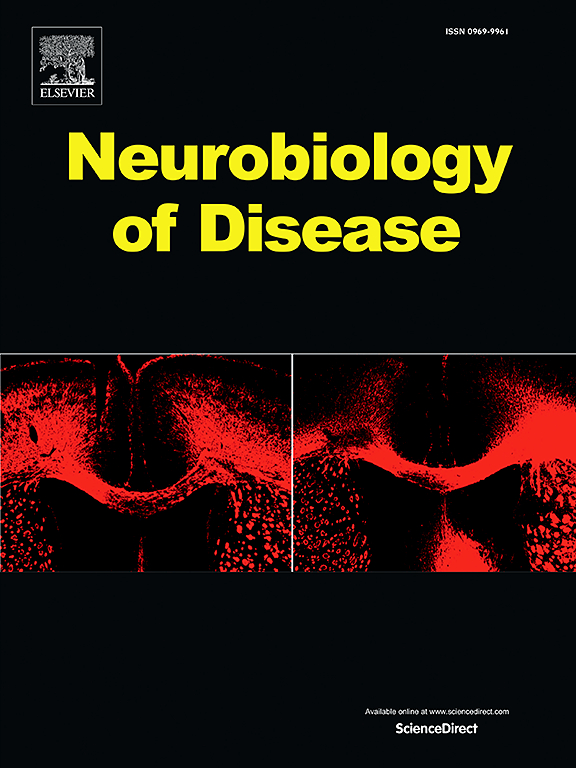α-突触核蛋白以DNA-PKcs调控的方式调节基因组DNA双链断裂的修复。
IF 5.1
2区 医学
Q1 NEUROSCIENCES
引用次数: 0
摘要
α-突触核蛋白(αSyn)是一种突触前和核蛋白,在帕金森病(PD)、帕金森病痴呆(PDD)和路易体痴呆(LBD)等重要的神经退行性疾病中聚集。我们过去的工作表明,在使用化疗药物博莱霉素诱导DNA损伤后,核αSyn可能会调节HAP1细胞中DNA双链断裂(DSB)的修复形式1。在这里,我们利用基于染色体外质粒的修复试验报告了αSyn的基因缺失特异性地损害了HAP1细胞中DSB修复的非同源末端连接(NHEJ)途径。值得注意的是,使用 CRISPR/Cas9 慢病毒方法在精确的基因组位置诱导单个 DSB,也显示了 αSyn 在 HAP1 细胞和小鼠原代皮质神经元培养物中调节 NHEJ 的重要性。这种对DSB修复的调节受DNA损伤应答信号激酶DNA-PKcs活性的调控,因为DNA-PKcs抑制可逆转αSyn功能缺失的影响。这些发现共同表明,αSyn 在调节转化细胞系和原代皮质神经元的 DSB 修复中发挥着重要的生理作用。这种核功能的缺失可能会导致在帕金森病、帕金森病综合症和雷诺氏脑病中发现的神经元基因组不稳定性,并指出 DNA-PKcs 是一个潜在的治疗靶点。本文章由计算机程序翻译,如有差异,请以英文原文为准。
Alpha-synuclein modulates the repair of genomic DNA double-strand breaks in a DNA-PKcs-regulated manner
α-synuclein (αSyn) is a presynaptic and nuclear protein that aggregates in important neurodegenerative diseases such as Parkinson's Disease (PD), Parkinson's Disease Dementia (PDD) and Lewy Body Dementia (LBD). Our past work suggests that nuclear αSyn may regulate forms of DNA double-strand break (DSB) repair in HAP1 cells after DNA damage induction with the chemotherapeutic agent bleomycin1. Here, we report that genetic deletion of αSyn specifically impairs the non-homologous end-joining (NHEJ) pathway of DSB repair using an extrachromosomal plasmid-based repair assay in HAP1 cells. Notably, induction of a single DSB at a precise genomic location using a CRISPR/Cas9 lentiviral approach also showed the importance of αSyn in regulating NHEJ in HAP1 cells and primary mouse cortical neuron cultures. This modulation of DSB repair is regulated by the activity of the DNA damage response signaling kinase DNA-PKcs, since the effect of αSyn loss-of-function is reversed by DNA-PKcs inhibition. Together, these findings suggest that αSyn plays an important physiologic role in regulating DSB repair in both a transformed cell line and in primary cortical neurons. Loss of this nuclear function may contribute to the neuronal genomic instability detected in PD, PDD and LBD and points to DNA-PKcs as a potential therapeutic target.
求助全文
通过发布文献求助,成功后即可免费获取论文全文。
去求助
来源期刊

Neurobiology of Disease
医学-神经科学
CiteScore
11.20
自引率
3.30%
发文量
270
审稿时长
76 days
期刊介绍:
Neurobiology of Disease is a major international journal at the interface between basic and clinical neuroscience. The journal provides a forum for the publication of top quality research papers on: molecular and cellular definitions of disease mechanisms, the neural systems and underpinning behavioral disorders, the genetics of inherited neurological and psychiatric diseases, nervous system aging, and findings relevant to the development of new therapies.
 求助内容:
求助内容: 应助结果提醒方式:
应助结果提醒方式:


